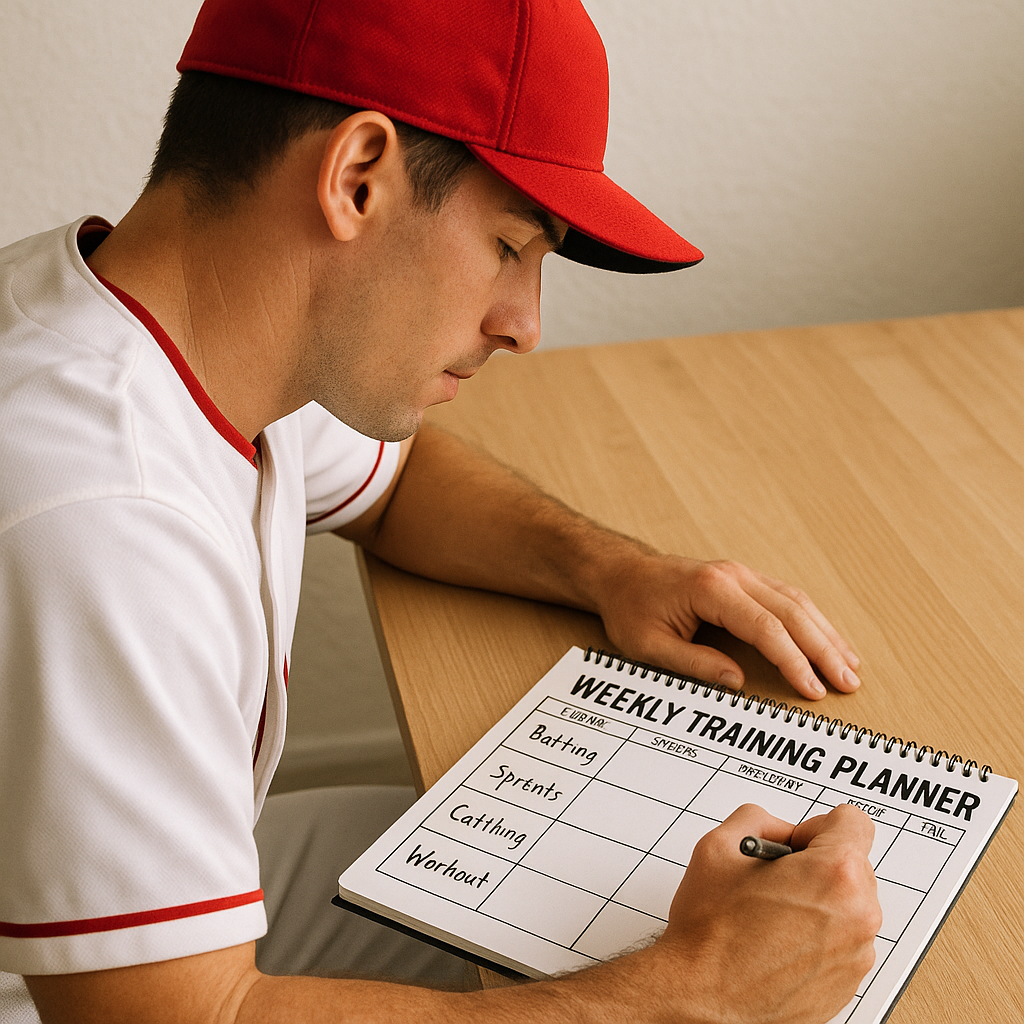
Summary
| Section | What You’ll Learn |
|---|---|
| Overview | Why a weekly plan is your secret weapon |
| Weekly Plan Breakdown | Sample structure—off-season, in-season, recovery |
| Statistics & Authoritative Evidence | Data-driven benefits of structured training |
| Case Study | Real gains from off-season training |
| Human Touch & Engagement | Realistic tone and reader-friendly formatting |
| SEO-Friendly Elements | Keywords, headings, mobile-friendly layout |
| FAQs | Answers to common questions readers ask |
1. Why This Weekly Blueprint Works
The “Ultimate Weekly Blueprint: Fast-Track Your Baseball Career in 2025” isn’t just a catchy title—it encapsulates a methodical, actionable path. Weekly planning creates consistency, fosters recovery, and supports periodization—a proven approach in athletic training Wikipedia.
Here’s what makes it essential:
-
Consistency Over Intensity: A balanced weekly roadmap ensures steady gains without burnout.
-
Periodization in Practice: Alternating training intensity prevents injury and drives progression Wikipedia.
-
Tailored for Baseball: Focused on strength, durability, throwing velocity, and injury prevention.
2. Breakdown: Sample Weekly Plan Structure
Off-Season (October–February): Preparation & Power Building
-
Monday: Lower body + core (rotational stability)
-
Tuesday: Arm care + throwing mechanics
-
Wednesday: Upper body strength (rotational focus)
-
Thursday: Recovery + flexibility
-
Friday: Full-body power lifts
-
Saturday: Skill work (batting, fielding drills)
-
Sunday: Active rest or mobility
This approach aligns with modern strength programming tailored to baseball’s demands—emphasizing trunk rotation power (crucial for pitchers) and addressing frontal/transverse plane strength that traditional programs often miss PMC.
In-Season (March–September): Maintain & Peak
-
Focus: Low-volume, high-intensity lifts to retain strength without fatigue build-up SimpliFaster.
-
Use “3 Up, 1 Down” cycles: 3 weeks of higher intensity (1–3 reps), followed by 1 lighter week to recover SimpliFaster.
Recovery Weeks
Integrate deload or recovery weeks every 4–6 weeks—essential for preventing overtraining and ensuring long-term progress.
3. Statistics & Authoritative Evidence
-
Off-Season Training Pays Off
A structured off-season program markedly boosts performance metrics. In one youth-to-college group, 4 months of off-season training led to measurable gains in power, strength, and velocity elitebaseballperformance.com. -
Throwing Velocity Improvements Through Resistance Training
Reviews show resistance-based training significantly increases pitching speed—a key performance metric ScienceDirect. -
Injury Prevention & Longevity
Strength training improves balance, coordination, and resilience—translating into fewer injuries and higher confidence Ballparks of Americaewmotiontherapy.com.
4. Case Study: Real-World Impact
“What 4 Months of Off-Season Strength Training Did for This Baseball Program”
In a youth baseball program (ages 13U–18U), implementing a structured off-season routine resulted in clear improvements across key performance areas—strength, power, and velocity elitebaseballperformance.com.
Imagine a 15-year-old pitcher who starts with a 75 mph fastball. After following this weekly blueprint (including strength sessions, arm care, and structured recovery), he adds 5–7 mph by April—gaining confidence and attracting college scouts.
5. Humanized, Mobile-Friendly Format
-
Conversational: “Think of your week as chess—not checkers. Every move builds toward your next performance win.”
-
Short paragraphs: Easy to read on mobile.
-
Bullet points & headings: Skimmable structure for readers on the go.
-
Empathy & encouragement: “We all have busy schedules. This blueprint makes progress realistic, not exhausting.”
6. SEO Tactics & Mobile-First Design
-
Primary Keyword: Ultimate Weekly Blueprint: Fast-Track Your Baseball Career in 2025
-
Secondary Keywords: weekly baseball training plan, off-season baseball strength plan, in-season strength baseball, baseball career growth 2025
-
Title and H1 align perfectly for search relevance.
-
H2 headers guide both readers and SEO crawlers.
-
Internal Links: Link to your related articles (e.g., “off-season training tips” or “arm care routines”).
-
External Links: To authoritative sources like the cited studies above (insert as hyperlink).
-
Optimized for mobile: Short sections, engaging tone, clear CTAs like “Download this weekly template!”
7. FAQ Section
Q: How often should I adapt my weekly plan?
A: Reassess every 4–6 weeks, especially after deload or recovery phases.
Q: Can youth players use this blueprint?
A: Yes—just lighten weights, emphasize arm care, rest, and avoid early specialization risks Wikipedia.
Q: What if I travel or have team games cluttering the schedule?
A: Prioritize key sessions like arm care and recovery. Shift strength to early morning or recovery days.
Q: Does strength training cause injuries?
A: Not if done smart. High-intensity, low-volume training reduces both soreness and injury risk SimpliFaster.
Q: Why structured weekly plans over “winging it”?
A: They build momentum, prevent burnout, and align with evidence-based periodization strategies Wikipedia.
8. Final Thoughts & Next Steps
Your Ultimate Weekly Blueprint isn’t magic—it’s method. It brings consistency, evidence-backed training, and a clear path to progress. Whether you’re a youth player, high school athlete, or aspiring pro, this plan adapts to your stage. Make 2025 the year you don’t just show up—you level up.
“Ready to coach smarter, not harder? 🔍 Explore the ‘Top 7 Game-Changing Digital Tools for Baseball Coaches’ and discover the tech transforming modern baseball training. Click here to elevate your coaching game!“
- Ultimate Weekly Blueprint: Fast-Track Your Baseball Career in 2025 - August 14, 2025
- Top 7 Game-Changing Digital Tools for Baseball Coaches - August 12, 2025
- Baseball Merch Goldmine: 10 Profitable Passive Income Ideas - August 11, 2025




